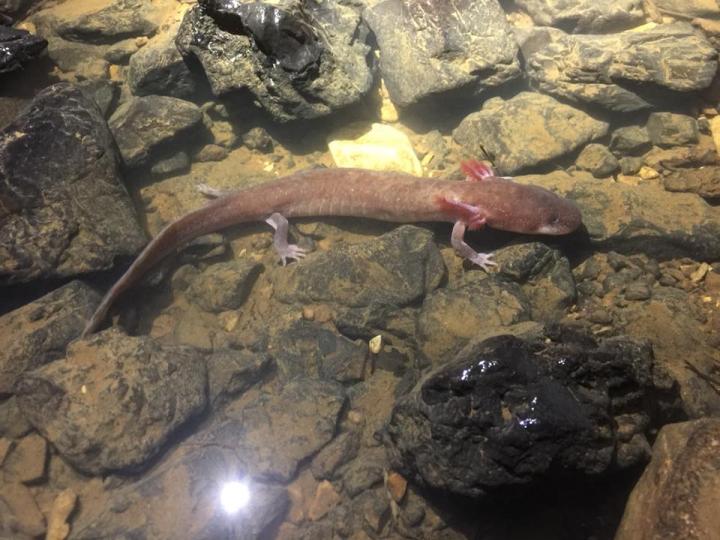Researchers discover record-breaking salamander

The largest specimen of Berry Cave Salamander measures 9.3 inches. Credit: Nicholas Gladstone/University of Tennessee, Knoxville.
“The record represents the largest individual within the genus Gyrinophilus, the largest body size of any cave-obligate salamander and the largest salamander within the Plethodontidae family in the United States,” said Nicholas Gladstone, a graduate student in UT's Department of Earth and Planetary Sciences, who made the discovery.
The find is making scientists reexamine growth limits of these animals in harsh environments and how hospitable underground environments really are.
Salamanders can be found in a variety of habitats across Tennessee. Some species have adapted to live in cave environments, which are thought of as extreme and inhospitable ecosystems due to the absence of light and limited resources.
Salamanders are one of only two vertebrate animal groups to have successfully colonized caves. The other is fish, said Gladstone.
The record-breaking specimen had some damage to the tail, leading researchers to believe that it was once nearly 10 inches long.
The Berry Cave Salamander can be found in only 10 sites in eastern Tennessee, and in 2003 it was placed on the US Fish and Wildlife Service's Candidate Species List for federal protection.
“This research will hopefully motivate additional conservation efforts for this rare and vulnerable species,” said Gladstone.
###
Ongoing research of the Berry Cave salamander is led by UT alumnus Matthew Niemiller, an assistant professor at the University of Alabama in Huntsville. Other members of this research team include Evin Carter (doctorate student in the UT Department of Ecology and Evolutionary Biology), Denise Kendall Niemiller (lecturer in the Department of Biological Sciences at the University of Alabama in Huntsville), and biologist Lindsey Hayter (rescue coordinator at Admiral Veterinary Hospital in Knoxville).
CONTACT:
Andrea Schneibel
andrea.schneibel@utk.edu
865-974-3993
Will Wells
yqk572@vols.utk.edu
Media Contact
More Information:
http://dx.doi.org/10.3897/subtbiol.28.30506All latest news from the category: Life Sciences and Chemistry
Articles and reports from the Life Sciences and chemistry area deal with applied and basic research into modern biology, chemistry and human medicine.
Valuable information can be found on a range of life sciences fields including bacteriology, biochemistry, bionics, bioinformatics, biophysics, biotechnology, genetics, geobotany, human biology, marine biology, microbiology, molecular biology, cellular biology, zoology, bioinorganic chemistry, microchemistry and environmental chemistry.
Newest articles

NASA: Mystery of life’s handedness deepens
The mystery of why life uses molecules with specific orientations has deepened with a NASA-funded discovery that RNA — a key molecule thought to have potentially held the instructions for…

What are the effects of historic lithium mining on water quality?
Study reveals low levels of common contaminants but high levels of other elements in waters associated with an abandoned lithium mine. Lithium ore and mining waste from a historic lithium…

Quantum-inspired design boosts efficiency of heat-to-electricity conversion
Rice engineers take unconventional route to improving thermophotovoltaic systems. Researchers at Rice University have found a new way to improve a key element of thermophotovoltaic (TPV) systems, which convert heat…



